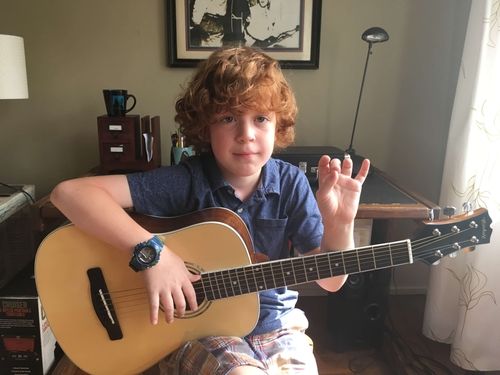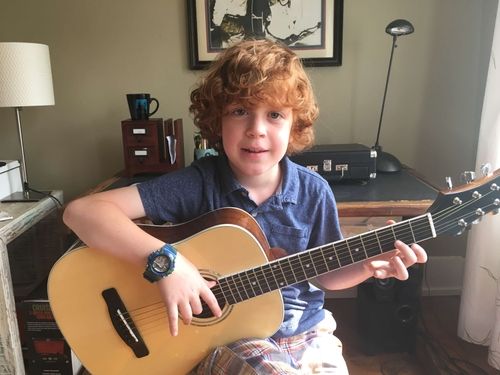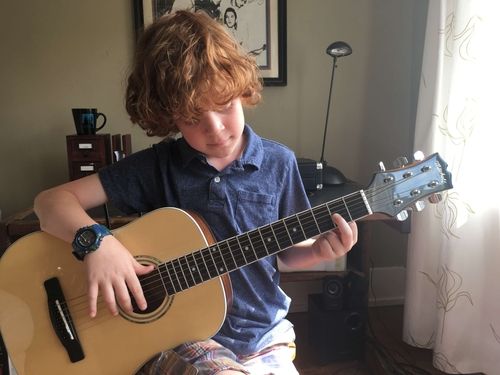Think of it like a pet or favorite toy. It's important to hold it the right way.
Here’s how:
- Sit on the edge of your chair.
- The guitar will touch your body in three places :
1 - Your right thigh (the top of your leg)
2 - Your chest (right by your heart)
3 - Your arm (near your right elbow) - Now wave your left hand.
Watch the video below to see how its done!
Practice showing your grown-up how to 1-2-3-wave- then let them have a turn!
P
R
A
C
T
I
C
E
N
O
T
E
S
←
→
Set Up
What to Watch For
How to Practice
Holding the Guitar
- Put your thumb on the top string.
- Pretend you fingers are dogs.
- Walk the dogs across the tops of the strings-don’t be afraid to get a BIG sound!
- Keep your thumb on the top string—it’s the leash.
- Put your fingers flat on the strings to stop the sound.
- Then walk the dogs again!
P
R
A
C
T
I
C
E
N
O
T
E
S
←
→
The Rest Stroke
No Choke
Chain

Independent
Dogs
Other
Sounds
- Put your thumb on the top string.
- Find the G String (Three up from the bottom).
- Walk your pointer finger over the G string and let it rest on the string above.
- Make the string say “Pep-per-o-ni Piz-za.

P
R
A
C
T
I
C
E
N
O
T
E
S
←
→
The G string is the third string from the bottom.
You should alternate between your pointer and middle fingers to pluck it.
The pep-per-o-ni notes are twice as fast as the piz-za notes (think short-short-short-short-long-long or ….—— ). Try to keep the tempo (speed) even and focus on only playing the G string.
Don’t worry if it is not perfect right away. The student will probably pluck the wrong strings a few times, praise their effort and remind them to try to only play the G string.
As they play keep an eye out for the following:
Thumb
Position
Choke
Chain
Independent
Fingers
There is a lot of muscle coordination and development going on here, so don’t worry too much if things seem a little awkward at first. Keep orienting back to the key points above and know that it will get better with practice.
- Put your thumb on the top string.
- Find the B string (two up from the bottom, right below the G).
- Walk your two fingers over the the B string, letting them rest on the G string.
- Make the string say “Pep-per-o-ni Piz-za.

P
R
A
C
T
I
C
E
N
O
T
E
S
←
→
Again, the pep-per-o-ni notes are twice as fast as the piz-za notes. The eventual goal is to play the rhythm confidently while only plucking the B string, but remember, it will take practice to get the hang of it.
The most challenging part of this exercise is developing the habit of resting the finger on the string above after plucking it. You might find that you have to put your hand next to the student to demonstrate the action.
Once the student can play the rhythm, they can try playing the rhythm on the G string and then the B string like so:

Use the play-along recording below to practice playing open G then open B. Don't worry about the order, or if you or your child match the recording perfectly. The goal is to have fun and get used to playing the open strings. Things will naturally get better with time.



Try plucking the string with your right hand while you're pressing on it with your left hand. And then again while you are not pressing on it.
You're playing different notes on the same string!
P
R
A
C
T
I
C
E
N
O
T
E
S
←
→
Neck
Fretboard
Frets
1. In the first step, the student makes a circle between the middle finger and the thumb. These two fingers should stay opposite one another when fretting notes.
2. Next you swing the left hand underneath the guitar and put the thumb behind the neck and the other fingers on the fretboard.
3. Finally you use the middle finger to press the string down just to the left of the fret.
Arch in the
Left Hand
Finger Tip
On String
Consistent
Pressure
Now we are going to play the note A!
- Play the open G string (HINT: "Open" means without pressing down on the fret.)
- Then press down the G string with your middle finger to the left of the second fret—this is the note A.
- Practice playing G then A.
- Now play A to G.
- Be sure to keep your fingers pointed toward the guitar the whole time.
.png)
P
R
A
C
T
I
C
E
N
O
T
E
S
←
→
The
Note 'A'
Left Hand
Technique
- The thumb is on the other side of the neck behind the middle finger with space between the neck and the palm of the hand.
- The finger is pressing down close to the right hand side of the fret (if you are too far back to the left in the fret you will hear a buzzing sound).
- The string is contacted with the center of the tip of the finger.
Keep It
Close
(We call this one 'Jelly' because it's so sweet!)

If you can't play it perfect now, don't worry!
Try to play it smoothly.
Every time you play, you get a little better.
P
R
A
C
T
I
C
E
N
O
T
E
S
←
→
Sections
Echo
Leap Frog
You can watch the video for practice or use the play-a-long below. The play-a-long features the song played three times. Initially, it may be very hard for your child to play along with it. This will get better over time. Remember, the goal is to have fun!
Our goal for today is to leave the instrument feeling happy, encouraged, and excited to play again tomorrow.